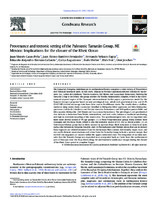| dc.description.abstract | The Huizachal–Peregrina Anticlinorium in northeastern Mexico comprises a wide variety of Precambrian
and Paleozoic basement units. In this work, Silurian-to-Permian unmetamorphosed siliciclastic successions (i.e., Cañón de Caballeros, Vicente Guerrero, Del Monte, and Guacamaya formations) forming the
Tamatán Group is described; the group overlies the Novillo metamorphic complex, which is the northernmost exposed region of the Oaxaquia microcontinent. In this paper, a provenance model for the
Tamatán Group is proposed based on new petrological data, whole-rock geochemical data, and U–Pb
LA-ICP-MS detrital zircon age data from these marine fossiliferous strata. The results show a shallowmarine to deep-water clastic succession classified as feldspatho-lithic-quartzose and litho-feldspathoquartzose (Cañón de Caballeros and Vicente Guerrero formations) and feldspatho-quartzo-lithic and
litho-quartzo-feldspathic (Del Monte and Guacamaya formations). The petrological and geochemical
data indicate a derivation from felsitic, intermediate, and basic rocks, intense to moderate weathering,
and high to moderate recycling of the source area. The geochronological data can be organized into
three main detrital zircon U–Pb age groups: (1) a Meso-Neoproterozoic group, likely derived from
Oaxaquia and the Maya block, which is also the probable source of 1.5–1.6 Ga zircon grains; (2) an
Ordovician–Silurian group that is likely sourced by igneous Maya Block intrusions or from local units
such as the Ordovician Peregrina Tonalite; and (3) Pennsylvanian and Permian zircon that can be derived
from magmatic arc-related intrusions from the diachronous Rheic closure. Additionally, major, trace, and
rare earth element concentrations and ratios from the Tamatán Group indicate a passive margin that
evolved into magmatic arc sources within the upper continental crust. The integration of our data indicates that the Tamatán Group was deposited in an unreported back-arc basin from the northernmost
part of Oaxaquia near the Maya Block along the northwestern Gondwanan margin during the closure
of the Rheic Ocean priori to complete Pangea. | en_US |

